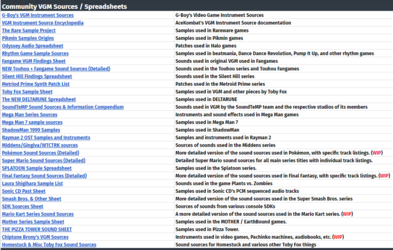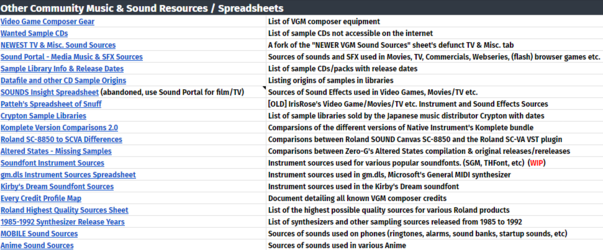- Joined
- Feb 13, 2022
What is Video Game Soundtrack Restoration?
Much like Art Restoration where the painter/artist attempts to do their best at retaining the quality and preservation of an old piece of art, Music Restoration for Video Game Music follows a very similar premise by using the original instruments/equipment composers used when developing the soundtracks of their game and attempting to make a "restored/remastered" version of it without the downsampling/compressing of samples beforehand in order to fit onto the game.
One of the earliest examples of "Music Restorations" for games would probably have to go to Jammin' Sam Miller when he set out to restore Donkey Kong Country's music for the Super Nintendo back in 2017.
But even before that, probably one of the earliest known instances of people "finding" high quality versions of samples in a game would go to EarthBound fans discovering that certain tracks have sampled some Beatles songs and other bands and sources for its own use:
But throughout the 2000s and 2010s, the thought of "restoring" a game's soundtrack without the bitcrushed and compressed samples wasn't really on anybody's radar nor did they think doing something like this was possible, until 2021 when the YouTube channel "Church of Kondo" (formally named "Brickster") uploaded the Super Mario World soundtrack using the original instruments that put the spotlight on the niche world of "restoring music".
From then on, a bunch of other channels and videos would pop up to try and take a stab at their own "restored/remastered" versions of game music. Here are some examples:
Pikmin 2's soundtrack in High Quality using original equipment by Waffles in LogicX:
They also put together an instrument pack for Pikmin 1 - 3
Mother 3's Soundtrack Restored by irikachana
Church of Kondo isn't just a Mario channel dedicated to restoring Mario music, but whatever else they find interesting to restore and upload since they're a team of people interested in VGM from any games:
Pokemon Restorations, channel dedicated to restoring and finding instruments for Pokemon Music, simple as:
Splatoon Sound Sources is just like Pokemon Restorations only for the Splatoon Series:
But how do they do this shit? Where do they find these instruments?
These two videos by SynaMax probably does the best demonstration over how one would go about discovering a composer's equipment and what they use via process of elimination and gathering as much info as they can from interviews and whatever else:
But most importantly, probably the single-most useful place to find what instruments and samples were used in a Game's Soundtrack would have to go to the "NEWER VGM Sound Sources" Google Sheet that ranges from games like Zelda, Mario, Sonic, HAL/Smash Bros., Square-Enix, etc. etc. (it's big): https://docs.google.com/spreadsheets/d/1JJBlHHDc65fhZmKUGLrDTLCm6rfUU83-kbuD8Y0zU0o/edit?usp=sharing
In the "Rules" section they also advertise other sheets by other members that goes into more details in other games like anything by Toby Fox in Undertale and Deltarune or in Pizza Tower, among other Miscellaneous sheets:


This thread is all about sperging over details over a game's music and audio because it really is such an interesting and niche topic to explore. The "what could have been" aspect of it if composers back then weren't limited by a console's hardware in the 90s and 00s, but were free to make these soundtracks in any way they wished, and these channels are giving a glimpse into that world by making restored versions of these tracks, it's some good shit.
So post whatever music stuff you think is interesting; other restored music videos, interesting composer tidbits, equipment, programs used for listening to game music in the best quality possible, etc.
Here's a final bonus tidbit I want to share since it's interesting: Did you know that the Roland Sound Canvas (the same Roland product used to make-up like 90% of Pokemon Ruby/Sapphire/Emerald's soundtrack) isn't even the highest quality their instruments could be? Instruments like the French Horn, Strings, Trumpet, Drums, etc. are actually compressed samples from Roland Sample CDs since they would have to fit onto the small ROM of the SC, whereas the large space of these CDs included even higher quality and bigger patches of these instruments.
You can see it in action from this video below by Sam Miller that uses the CD instruments instead of the ones from Sound Canvas:
A download to these Sample CDs can be found on archive.org: https://archive.org/details/roland-sample-cd-roms
Much like Art Restoration where the painter/artist attempts to do their best at retaining the quality and preservation of an old piece of art, Music Restoration for Video Game Music follows a very similar premise by using the original instruments/equipment composers used when developing the soundtracks of their game and attempting to make a "restored/remastered" version of it without the downsampling/compressing of samples beforehand in order to fit onto the game.
One of the earliest examples of "Music Restorations" for games would probably have to go to Jammin' Sam Miller when he set out to restore Donkey Kong Country's music for the Super Nintendo back in 2017.
But even before that, probably one of the earliest known instances of people "finding" high quality versions of samples in a game would go to EarthBound fans discovering that certain tracks have sampled some Beatles songs and other bands and sources for its own use:
But throughout the 2000s and 2010s, the thought of "restoring" a game's soundtrack without the bitcrushed and compressed samples wasn't really on anybody's radar nor did they think doing something like this was possible, until 2021 when the YouTube channel "Church of Kondo" (formally named "Brickster") uploaded the Super Mario World soundtrack using the original instruments that put the spotlight on the niche world of "restoring music".
From then on, a bunch of other channels and videos would pop up to try and take a stab at their own "restored/remastered" versions of game music. Here are some examples:
Pikmin 2's soundtrack in High Quality using original equipment by Waffles in LogicX:
But how do they do this shit? Where do they find these instruments?
These two videos by SynaMax probably does the best demonstration over how one would go about discovering a composer's equipment and what they use via process of elimination and gathering as much info as they can from interviews and whatever else:
In the "Rules" section they also advertise other sheets by other members that goes into more details in other games like anything by Toby Fox in Undertale and Deltarune or in Pizza Tower, among other Miscellaneous sheets:


This thread is all about sperging over details over a game's music and audio because it really is such an interesting and niche topic to explore. The "what could have been" aspect of it if composers back then weren't limited by a console's hardware in the 90s and 00s, but were free to make these soundtracks in any way they wished, and these channels are giving a glimpse into that world by making restored versions of these tracks, it's some good shit.
So post whatever music stuff you think is interesting; other restored music videos, interesting composer tidbits, equipment, programs used for listening to game music in the best quality possible, etc.
Here's a final bonus tidbit I want to share since it's interesting: Did you know that the Roland Sound Canvas (the same Roland product used to make-up like 90% of Pokemon Ruby/Sapphire/Emerald's soundtrack) isn't even the highest quality their instruments could be? Instruments like the French Horn, Strings, Trumpet, Drums, etc. are actually compressed samples from Roland Sample CDs since they would have to fit onto the small ROM of the SC, whereas the large space of these CDs included even higher quality and bigger patches of these instruments.
You can see it in action from this video below by Sam Miller that uses the CD instruments instead of the ones from Sound Canvas: